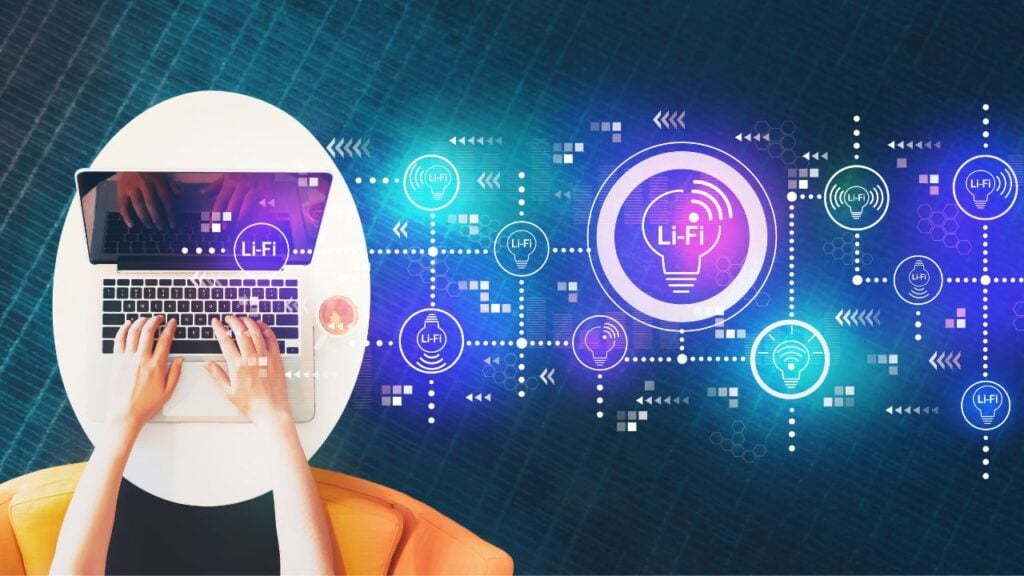Is LiFi a real alternative to WiFi?
Table of Contents

LiFi systems use visible light to transmit data at high speed and avoid interference with other devices
Is it possible to connect to the internet just by switching on the light? With LiFi, a data transmission system based on visible light, the answer is a resounding yes. But what are the advantages and disadvantages of this solution compared to WiFi, could it relegate routers to the past, and what are its real applications?
To understand what LiFi is all about, we need to go back to 2011, when Harold Haas, a professor at the University of Edinburgh, first mentioned the term. The engineer presented LiFi technology (an acronym for Light Fidelity) at a TED Talk, introducing the world to a new wireless communications system that replaced radio waves with visible light or VLC (Visible Light Communication). Thus, a rival to WiFi was born.
More than a decade later, its development is still going strong. In mid-2023, the Institute of Electrical and Electronics Engineers approved the first LiFi standard: IEEE 802.11BB. However, this solution has not yet become firmly established in society. Why?
How does LiFi work?
To understand why LiFi has not yet made its way into the everyday lives of citizens and businesses, it is essential to understand how it works and, more specifically, the answer to a key question: how can light transmit data?
LiFi is based on altering the frequency of visible light, i.e. between 400 and 800 THz. To do this, LED bulbs are used which, depending on the data they receive from the encoder (the device to which the internet signal arrives), flicker on and off at a speed that is completely imperceptible to the human eye.
This flickering, however, is perceived by a photoreceptor, which must be connected to the end user’s device. Thanks to this photoreceptor, the mobile phone or computer can interpret the data from the bulb and consequently connect to the network.
Initially, the German researcher announced in his talk that the speed of LiFi could be around 10 Mbps. In the years since, however, tests have been carried out with infrared beams that leave this figure far behind.
At the University of Eindhoven, download speeds of up to 42.8 Gbps were achieved using antennas placed at a distance of two and a half meters. In laboratory tests, the speed was further increased to 224 Gbps. However, solutions currently on the market range from 600 Mbps to 1 Gbps.
Advantages of LiFi
Speed is undoubtedly one of the most attractive advantages of LiFi. According to data compiled by High Speed Internet, the average internet speed in the United States is 42.86 Mbps. LiFi, as we have just seen, far exceeds this figure, so it could be an interesting solution when speed is a priority.
There is another key issue: cost. How does LiFi affect the wallet, and is it affordable for all budgets? In general, the implementation of these systems is not extremely expensive, as it is sufficient to incorporate the equipment into LED bulbs and add the photoreceptor to the electronic devices. Moreover, their energy consumption is not very high.
Moreover, its accessibility is significantly superior to that of WiFi. Any luminaire, if it is equipped with a LiFi transmitter, could allow anyone to connect to the internet.
LiFi also addresses one of the most common drawbacks of WiFi: interference. WiFi connections accumulate in the 2.4 GHz, 5 GHz, and 6 GHz bands, leading to connection problems as the radio spectrum becomes increasingly saturated.
LiFi can broadcast on many more wavelengths, avoiding this overlap, increasing the volume of data that can be sent at the same time, and saying goodbye to interference with other devices.
And what about security? This is also substantially increased. Why? Radio waves pass through obstacles like walls, even if they are opaque. Light does not. This significantly strengthens the protection barriers, as intruders will not be able to eavesdrop on communications through walls. If there is no direct access to light, there is no connection. For this reason, LiFi can be an ideal alternative for companies or organizations that handle confidential information or sensitive data of their customers or employees.
Finally, it is important to mention another major strength of LiFi. LiFi could bring the internet to places where it is currently not possible to have a network connection. WiFi waves interfere with radio communications, such as those of ships or airplanes. This is not the case with light. LiFi could therefore be a very useful solution for connecting to the internet during flights or in sensitive areas of hospitals.
Disadvantages of LiFi

But there are two sides to every coin. LiFi also has several drawbacks that could deter users or companies from using it.
To begin with, its range is very limited. The end device has to receive the light directly, without any obstacles. This means that, as mentioned above, LiFi is not able to pass through walls. An advantage from an information security point of view, but a disadvantage when considering usability. Its range of coverage is far less than that of WiFi, as it is usually no more than ten meters, which means that users can hardly move around.
In addition, without light, there is no connection. Therefore, it is necessary to continuously illuminate the area in which you want to access the internet. In the case of a large home or office, a large number of transmitter bulbs must be installed to connect all areas.
The sensitivity of this system is another weakness. Any object or obstacle that physically interferes with the photoreceptor, such as placing a hand on it or walking in front of the light, could result in a slowdown or even a cut-off of the connection.
This makes it necessary to keep the devices in constant exposure to light. Simple enough when it comes to computers. But what about mobile phones? A lot of the time, they are in bags or pockets, preventing their photoreceptors from capturing light and therefore no connection to the network.
A worthy rival to WiFi?
After weighing up the benefits and limitations of LiFi, several crucial questions arise: could it pose a threat to WiFi, will there be a future shift of users from one to the other, and which solution is more advantageous?
It all depends on how you look at it. In terms of technical specifications, LiFi leaves WiFi far behind. It is faster, more secure, and generates less interference with other devices.
But when it comes to user experience, the difference between the two is very noticeable. In this case, in favor of WiFi. LiFi’s range is shorter, its ability to avoid obstacles is more limited and Internet users must be permanently exposed to light.
These are precisely some of the reasons why its use has not expanded on a large scale. It is a relatively new technology, just over a decade old, and its use is not yet practical for ordinary citizens.
However, the developers of the system themselves are aware of its limitations. For this reason, its current applications are more oriented toward very specific environments, such as airplanes or hospitals.
For the time being, LiFi does not aspire to be present in every home or office, which, at least shortly, will continue to use routers and WiFi technology to connect to the internet.
